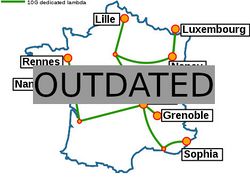Grid5000:Home
|
Grid'5000 is a large-scale and flexible testbed for experiment-driven research in all areas of computer science, with a focus on parallel and distributed computing including Cloud, HPC and Big Data and AI. Key features:
Grid'5000 is merging with FIT to build the SILECS Infrastructure for Large-scale Experimental Computer Science. Read an Introduction to SILECS (April 2018)
Older documents:
|
Random pick of publications
Five random publications that benefited from Grid'5000 (at least 2928 overall):
- Céline Acary-Robert, Emmanuel Agullo, Ludovic Courtès, Marek Felšöci, Konrad Hinsen, et al.. Guix-HPC Activity Report 2022–2023. Inria Bordeaux - Sud Ouest. 2024, pp.1-32. hal-04500140 view on HAL pdf
- Alexandre Bonvoisin, Clément Quinton, Romain Rouvoy. Understanding the Performance-Energy Tradeoffs of Object-Relational Mapping Frameworks. SANER'24 - 31th IEEE International Conference on Software Analysis, Evolution and Reengineering, Mar 2024, Rovaniemi, Finland. pp.11. hal-04401643v2 view on HAL pdf
- Chih-Kai Huang. Scalability of public geo-distributed fog computing federations. Other cs.OH. Université de Rennes, 2024. English. NNT : 2024URENS055. tel-04910860v2 view on HAL pdf
- Cédric Prigent, Alexandru Costan, Gabriel Antoniu, Loïc Cudennec. Enabling Federated Learning across the Computing Continuum: Systems, Challenges and Future Directions. Future Generation Computer Systems, 2024, 160, pp.767-783. 10.1016/j.future.2024.06.043. hal-04659211 view on HAL pdf
- Mateusz Gienieczko, Filip Murlak, Charles Paperman. Supporting Descendants in SIMD-Accelerated JSONPath. International Conference on Architectural Support for Programming Languages and Operating Systems (ASPLOS 2024), 2024, San Diego (California), United States. pp.338-361, 10.4230/LIPIcs. hal-04398350 view on HAL pdf
Latest news
Failed to load RSS feed from https://www.grid5000.fr/mediawiki/index.php?title=News&action=feed&feed=atom: Error parsing XML for RSS
Grid'5000 sites
Current funding
As from June 2008, Inria is the main contributor to Grid'5000 funding.
INRIA |
CNRS |
UniversitiesUniversité Grenoble Alpes, Grenoble INP |
Regional councilsAquitaine |


